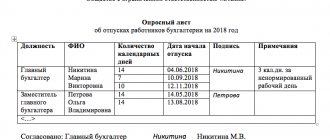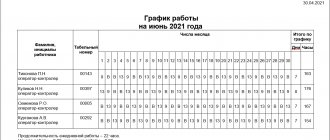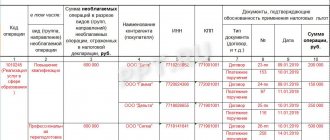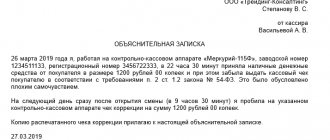Drawing up a vacation schedule is the responsibility of every organization. Usually it is developed in advance: 2 weeks before the next calendar year and approved by order of the boss. According to the provisions of Art. 123 of the Labor Code of the Russian Federation, compliance with the vacation schedule is mandatory for the employer and employee. In this regard, many HR specialists have a question: are changes to the vacation schedule allowed, what documents need to be prepared in this case? How to make changes to the schedule when rescheduling vacation? How to adjust the schedule when hiring a new employee? Let's figure it out.
Normative base
The employer’s obligation to draw up a vacation schedule follows from Article 123 of the Labor Code of the Russian Federation. It must be approved for the next year no later than 2 weeks before the end of the current year. For example, the vacation schedule for 2021 had to be approved no later than December 17, 2020.
All employers create a vacation schedule. Only micro-enterprises that have refused to adopt internal regulations can not do this (Article 309.2 of the Labor Code of the Russian Federation). However, in this case, it is necessary to conclude a written agreement with each employee and record this fact in clause 22 of the Model Employment Contract.
Before drawing up a vacation schedule, you need to take into account that in addition to the main paid rest period of 28 days (Articles 114-115 of the Tax Code of the Russian Federation), some categories of workers are entitled to additional days (Articles 116-119 of the Tax Code of the Russian Federation).
If an employee has been working for the first year, he has the right to count on rest after 6 months. But there are cases when it should be provided earlier if the employee has expressed such a desire (Article 123 of the Labor Code of the Russian Federation). Women before and immediately after maternity leave, minors, persons who have adopted a child under three months old, and some others have the right to count on this (Article 122 of the Labor Code of the Russian Federation).
These categories of employees also have the right to receive leave at any time convenient for them. In addition, one of the parents/guardians of a disabled minor child, veterans, Chernobyl victims, blood donors, spouses of military personnel, part-time workers and other categories have this right.
It is impossible not to provide an hired person with leave for two years in a row (Article 124 of the Labor Code of the Russian Federation), even if he himself requests it. If the rest period for the previous year was not fully used, the remaining days must be included in the vacation schedule for the next year. First, the document reflects the previous year’s period, and then the period corresponding to the year in which it is compiled.
The annual rest period can be divided into parts, but one of them should not be less than 14 calendar days (Article 125 of the Tax Code of the Russian Federation).
Changing your planned holiday date
All other adjustments to the schedule are usually associated with the fact that the employee is forced to rest earlier or later than the deadline set for him. In this case, changes to the vacation schedule in 2021 should be made in the following scheme: the planned start date of the event, entered in column 6, is not changed, and all necessary information about postponing the start of the vacation or changing its duration is reflected in columns 8–10.
Please note that not all HR employees know how to make changes to the vacation schedule in accordance with the law. In particular, many of them forget about the provisions of Art. 123 Labor Code of the Russian Federation. It says that if an employee has the right to go on vacation in a certain month, then 2 weeks before the expected start of the vacation he must write an application indicating a specific date. This is what needs to be entered in column 8.
The requirement that employees are required to notify the employer of the start date of vacation no later than half a month in advance should preferably be enshrined in an internal company regulation - an order or directive. Also, nothing prevents you from introducing a corresponding clause into the wage regulations. Moreover, all company employees are required to carefully study these documents. The same applies to the order to amend the vacation schedule: all interested employees must familiarize themselves with it and sign it.
Keep in mind that some employees of the organization have the right to take vacation at any time suitable for them. These include:
- teenagers under 18 years of age;
- part-time workers; they rest at the same time at their main and additional places of work;
- employees planning to go on maternity leave;
- husbands whose wives are on maternity or child care leave;
- employees with two or more children of a certain age (under 12 years);
- honorary donors;
- military spouses vacationing at the same time as their husbands;
- some categories of Chernobyl victims;
- employees who adopted a baby under three months of age;
- other categories in accordance with the provisions of Art. 322 Labor Code of the Russian Federation.
See also “What types of holidays are there?”
If an employee belonging to one of these categories decides to postpone the planned start date of the vacation, the vacation schedule is not changed at the initiative of the employee. In this case, it is enough to enter the relevant data into the existing document:
- in column 8 - reflect information about the employee’s application with a request to postpone the rest period;
- in column 9 - indicate the new date of the proposed vacation;
- in column 10 - write down the category of employee who has the right to use vacation at any time.
It will not be possible to find an approved example of changing the vacation schedule in regulatory documents. Therefore, for your convenience, below is an approximate form of the adjusted schedule, which is informative and convenient for work.
Is it necessary to use a unified form?
There is a standard form of the vacation schedule - it was approved by Decree of the State Statistics Committee of the Russian Federation dated January 5, 2004 No. 1. However, since 2013, the obligation to use this unified form has been canceled. The employer has the right to develop the document himself, including all the necessary details, and properly approve it.
In practice, most organizations still use the T-7 form, since it is convenient and time-tested. It is often supplemented in Excel with the necessary columns, for example, for employee signatures during familiarization.
New clarifications from officials about the vacation schedule
Before we tell you how to fill out the form and who to include in it, here is a short overview of some of the latest letters from regulatory authorities. They provide answers to the questions that employers asked when drawing up their vacation schedule for 2021.
It is not necessary to take into account the opinion of each hired person when forming a vacation schedule (letter of the Ministry of Labor dated December 9, 2020 No. 14-2/OOG-17854). However, if the organization has a trade union, then the document must be agreed upon with it, regardless of the number of its members (letter of the Ministry of Labor dated December 8, 2020 No. 14-2/OOG-17785). The main thing is that this body represents the interests of at least half of the employees. If there is only one representative of the workforce in the organization, the document must also be agreed upon with him (provided that this representative was elected by secret ballot by at least 50% of the employees).
Everyone who has an employment relationship with the organization must be included in the vacation schedule when it is approved. Including those who leave within a year, for example, at the end of a fixed-term employment contract. And even those who, at the time of drawing up the vacation schedule, are already on vacation and subsequently quit (Rosrud letter dated 03/09/2021 No. PG/03709-6-1).
At the same time, in earlier letters of the Ministry of Labor (dated 12/09/2020 No. 14-2/ОOG-17851, dated 12/10/2020 No. 14-2/ОOG-17893, dated 12/10/2020 No. 14-2/ОOG-17895, dated 12/08. 2020 No. 14-2/OOG-17800) states that employers can decide for themselves whether certain categories of employees should be included in the vacation schedule. Appropriate regulation must be enshrined in local regulations.
The Ministry of Labor gave the same answer to the following questions:
- Is it necessary to reflect in the document the rest days not used by the employee for the previous year (letter dated 12/09/2020 No. 14-2/OOG-17850);
- whether the form should contain a specific date for the start of the vacation (letter dated 12/08/2020 No. 14-2/OOG-17783).
Thus, the department believes that employers can make decisions on these issues independently, but this needs to be enshrined in the LNA. Therefore, if there are no relevant acts, then it will be safer to fill out the vacation schedule for the next year for all persons who work in the organization, take into account all previously unused days, and also reflect the dates.
Part-time workers, including internal ones, should also be included in the document (letter of Rostrud dated December 25, 2020 No. PG/60005-6-1).
The approved vacation schedule is brought to the attention of the team. In addition, each employee must be notified of the start time of his vacation no later than two weeks in advance (letter of Rostrud dated December 24, 2020 No. PG/59245-6-1). At the same time, the letter of the Ministry of Labor dated December 9, 2020 No. 14-2/OOG-17846 states that the Labor Code does not contain direct instructions on the need for hired persons to familiarize themselves with the schedule.
Employees who can choose a rest period have the right to change the start date appearing in the document (letter of the Ministry of Labor dated December 8, 2020 No. 14-2/OOG-17786).
How to write an application for a vacation schedule
An employee’s application for a vacation schedule is drawn up in any form, usually addressed to the head of the company. It indicates the planned period of vacation provision in the coming year, indicating the number of days of rest.
***
An application for inclusion in the vacation schedule is written by employees who have the priority right to grant vacation. In other cases, there is no need to write such a statement. The employer has the right to take into account the opinions and wishes of all employees regarding the timing of vacation, but is not obligated.
Whose opinion should I take into account?
Employees' annual holidays are usually planned taking into account their opinions, although the employer has no such obligation. For obvious reasons, all wishes cannot be taken into account, especially in large organizations. But still, employers try to accommodate the team halfway whenever possible.
But the opinion of the trade union organization, if it is created, must be taken into account when drawing up the vacation schedule. There is an important nuance: it should be agreed only with the trade union that represents more than half of all employees.
Above we have given the basic rules for drawing up a document. Next, we propose to analyze this process step by step.
Vacation schedule: step-by-step instructions
Drawing up a vacation schedule begins with collecting statements from employees about their desired rest periods. If the enterprise is large, then such work can be assigned to the heads of structural divisions. Then all information is transferred to the personnel department. Based on it, a draft document is drawn up.
Step 1. Filling out using the unified form as an example
Now let’s figure out how to fill out the vacation schedule, and take the T-7 form as a basis. First of all, you need to enter the data in the “header” - the name of the employer, its OKPO (for organizations only) and the year for which the document is being drawn up. There is no need to enter the date and number yet.
The unified form contains a table - it reflects information for each employee. At the time of drawing up the project, the following fields are filled in:
- Column 1 – name of the structural unit (department) in which the employee works;
- column 2 – his position (specialty) according to the staffing table;
- column 3 – first name, last name and patronymic;
- column 4 – personnel number;
- Column 5 – number of days of rest. If it is divided, each part is indicated sequentially;
- Column 6 – planned start date of vacation. Employers do not always immediately enter dates into the vacation schedule, because the rules for drawing up the document do not require this. However, there is no point in not specifying a specific period for which the employee is released from work. Therefore, we recommend specifying not only the month, but also the date. If the need arises in the future, changes can be made to the vacation schedule.
Columns 7-9 are not filled in at the time of drawing up the document. Column 7 is intended to indicate the actual start date of the vacation, columns 8 and 9 are intended to reflect information about its transfer. If necessary, you can enter a note in column 10. For example, how many days have been carried over from last year.
Step 2. Coordination with the trade union
The completed form must be sent to the trade union committee. For this purpose, a covering letter is drawn up in two copies. One is transferred to the trade union along with the schedule, and on the other, its representative will put a mark on acceptance of the documents. This is necessary to record the date of their transfer. Within 5 working days, the trade union must review the schedule and issue its reasoned opinion in writing.
Let's say a representative body does not agree with the project and proposes to modify it. The employer can accept the comments and adjust the schedule in accordance with them. If he does not agree to this, consultations with the elected body of the trade union must be held within three days to resolve all issues. However, if the parties do not reach a consensus, the manager will still be able to approve the document, but will have to draw up a protocol of disagreements. The trade union will retain the right to appeal this decision to the State Labor Inspectorate or in court, as well as initiate a collective labor dispute.
Step 3. Signing
Now the document is handed over to the head of the HR department for signing. He indicates his position and signs with a transcript.
Step 4: Approval
The next stage is approval of the vacation schedule. It contains the document number in accordance with the numbering accepted by the employer, the date and position of the manager. A note is also made that the union’s opinion has been taken into account, indicating the date and document number. The manager signs and deciphers it.
Step 5. Familiarization
As already mentioned, the Labor Code of the Russian Federation does not directly oblige the employer to familiarize the team with the vacation schedule. However, this should still be done. Firstly, officials’ explanations on this matter are ambiguous, and it is better to protect yourself from possible claims from the State Tax Inspectorate. Secondly, it is convenient for the employee to know in advance exactly when he will rest. After all, the period for which he must be warned by law (which is two weeks) is very short.
You can familiarize the team with the approved document in different ways, for example:
- create a special journal in which each employee will sign;
- provide an additional column in the T-7 form by adjusting the standard form in Excel;
- collect employee signatures on the back of the document.
Who should write an application for inclusion in the vacation schedule?
Most employees are not required to write a statement requesting inclusion in the vacation schedule. Their opinions and wishes can be indicated in any other way, even verbally, but the employer is not obliged to set vacation dates in exactly this way. However, there are a number of categories of employees for whom the employer is obliged to plan and arrange vacation at a time of their choosing. For such citizens, a written application is required. Categories that have benefits when granting leave include:
- minors (Article 267 of the Labor Code of the Russian Federation);
- one of the parents (adoptive parents) of a disabled minor child (Article 262.1 of the Labor Code of the Russian Federation);
- WWII participants, combat veterans, war invalids (Articles 14–19 of Law No. 5-FZ dated January 12, 1995);
- Heroes of Russia, the USSR, Socialist Labor, full holders of the Order of Glory, Labor Glory (Article 8 of the Law of the Russian Federation of January 15, 1993 No. 4301-1, Article 6 of the Law of January 9, 1997 No. 5-FZ);
- Honorary Donors of Russia and Honorary Donors of the USSR living in Russia (Article 23 of Law No. 125-FZ of July 20, 2012);
- persons exposed to radiation as a result of the Chernobyl disaster, as well as other accidents at nuclear facilities (Article 15 of the Law of the Russian Federation of January 15, 1991 No. 1244-1).
After a six-month period from the date of employment, the employer is obliged, if there is an application from the employee, to issue leave to the following persons (Article 122 of the Labor Code of the Russian Federation):
- minors;
- employees who adopted a child before the child was three months old;
- new employees.
If the end of this period falls on the next calendar year, then the employer should take into account the wishes of these employees when drawing up the vacation schedule.
Provide the employee with annual leave in advance if it is planned in the vacation schedule or the employee has the right to use it at a time convenient for him, for example, a minor. In other cases, you can provide the leave in advance if you agree. But there are cases when we do not recommend doing this, for example, if an employee asks for leave in advance for the next working year.
The company is also obliged to take into account the interests of the following employees:
- pregnant women - before or after maternity leave, regardless of the length of service in the company (Article 260 of the Labor Code of the Russian Federation);
- husbands who want to take advantage of leave during their wife’s maternity leave, regardless of the duration of work in this organization (Article 123 of the Labor Code of the Russian Federation);
- spouses of military personnel wishing to spend a vacation with their spouse (Article 11 of Law No. 76-FZ dated May 27, 1998);
- one of the parents accompanying a minor child resident of the Far North to another region for admission to a university.
When accepting a new employee, after the vacation schedule has been approved, you can issue a corresponding supplement.
Execution and change
2 weeks before the vacation date, you should remind about it by sending a notice to the employee. Alternatively, you can issue the order immediately. The main thing is to do this at least 14 days before the start of the rest period. Its actual date is noted in column 7 of form T-7.
Execution of the approved document is mandatory for both parties to the labor relationship. This means that the employer cannot refuse a planned vacation, and the employee cannot refuse it. But by agreement of the parties, the rest time can be postponed. In this case, the employee writes a statement, and changes are made to the schedule.
To correct the document, an order from the manager is issued, which indicates the essence of the changes. Columns 7-10 of the T-7 form reflect new data. Similarly, the vacation schedule can be changed to include an employee who was hired after the document was approved. However, this is not necessary - you can provide him with a period of rest on the basis of an order.
Mistake No. 2: not all vacations are indicated
Check to see if the approved vacation schedule includes additional paid or unused employee vacations.
Let us recall that the vacation schedule contains information about annual paid leave, which, in turn, consists of basic paid and additional paid leave. The largest number of questions are related to annual additional leave for hazardous working conditions . In accordance with Art. 117 of the Labor Code of the Russian Federation , it is provided based on the results of a special assessment of working conditions carried out in accordance with Law No. 426-FZ [1]. The minimum duration of such leave is seven calendar days.
Such leave must be reflected in the schedule. If the enterprise uses the T-7 schedule [2], for this purpose, in column 6 of this form only the start date of the vacation is reflected, and the end date will be determined only by the day the order to grant the vacation is drawn up. In column 5 of the vacation schedule, it is necessary to reflect the number of calendar days of vacation - it is determined by adding the number of days of main paid and additional paid vacation. For example, an employee is entitled to 30 calendar days of basic paid leave and 7 additional calendar days, which means that in column 5 you need to write “37”.
For your information
Based on Art. 122 , 124 of the Labor Code of the Russian Federation, annual paid leave must be provided to the employee annually. In exceptional cases, when the provision of leave in the current working year may adversely affect the normal course of work of the organization, it is allowed, with the consent of the employee, to transfer the leave to the next working year. Then the leave must be used within 12 months after the end of the working year for which it is granted.
Unused vacations must also be indicated in the schedule. An employee may have unused vacations for a number of reasons: due to postponement of vacation at the initiative of the employer, recall from vacation, etc. (Articles 122, 124 of the Labor Code of the Russian Federation, Part 9.2 of Article 46 of Law No. 79-FZ). Then the new dates of the expected vacation and the grounds for transferring the employee’s rest are indicated in columns 8, 9. By reflecting such vacations, it is easier for the employer (employer) to control their use, since failure to provide annual paid leave for two years in a row is prohibited.
Storing vacation schedules
The vacation schedule is stored for three years. This period is indicated in the List of standard management archival documents, approved by order of the Federal Archive of the Russian Federation dated December 20, 2019 No. 236.
We have given the basic rules in accordance with which the vacation schedule is drawn up, a sample for filling it out, and also talked about many of the subtleties of this document. In conclusion, we add that for its absence a fine may be imposed under Article 5.27 of the Code of Administrative Offences. For officials and individual entrepreneurs it will be 1-5 thousand rubles, for enterprises – 30-50 thousand rubles.







